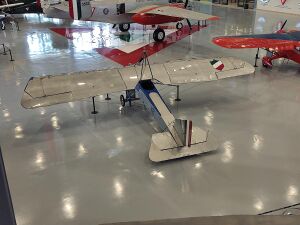Engineering:TNCA Serie H
| TNCA Serie H "Parasol" | |
|---|---|

| |
| TNCA Serie H in Museo Militar de Aviación | |
| Role | Bomber |
| National origin | |
| Manufacturer | TNCA |
| First flight | 1916 |
| Status | retired |
| Primary users | Mexican Air Force -> |
| Number built | 13 |
The TNCA Serie H "Parasol" was a Mexican bomber and reconnaissance aircraft manufactured by the Talleres Nacionales de Construcciones Aeronáuticas (TNCA). It was a high-wing monoplane (which was very unusual at the time), which allowed better speed performance. It was one of the first aircraft models made by TNCA and was designed as a "Technology Tester", in order to improve the designs of subsequent models. Its design was very similar to the Morane-Saulnier L, especially the design of the landing gear, mast and the controls of the rudders, however the fuselage structure was made of metal tubes. It was powered by a 60 HP TNCA Aztatl six cylinders air cooled engine, with an Anáhuac propeller.
The aircraft did not have fixed weapons, however side-shot machine guns could be mounted, and bombs could be carried under the fuselage.[1][2][3][4]
One example of the Serie H is preserved at the Mexican Air Force Museum (Museo Militar de Aviacion) in Santa Lucía.
Specifications
Data from Airwar.ru,[5] SEDENA,[6] Wikimedia commons[7]
General characteristics
- Crew: 1
- Capacity: 1 gunner
- Length: 7.2 m (23 ft 7 in)
- Wingspan: 11.7 m (38 ft 5 in)
- Height: 3.6 m (11 ft 10 in)
- Wing area: 17 m2 (180 sq ft)
- Empty weight: 350 kg (772 lb)
- Powerplant: 1 × TNCA Aztatl 6-cylinder air-cooled radial piston engine, 45 kW (60 hp)
- Propellers: 2-bladed Anáhuac
Performance
- Cruise speed: 120 km/h (75 mph, 65 kn)
- Range: 333 km (207 mi, 180 nmi)
- Service ceiling: 1,800 m (6,000 ft)
Armament
- 1 × 7.92 mm Rexer Machine gun
- 6 × 12 lb (5.4 kg) Chapultepec Bombs
References
- ↑ "TNCA aircraft, the Series H and the 3-E-130 series". https://sites.google.com/site/aircraftmanufacturinginmexico/tnca-aircraft.
- ↑ SEDENA. "Material aéreo histórico de la F.A.M." (in Spanish). https://www.gob.mx/sedena/documentos/material-aereo-historico-de-la-f-a-m.
- ↑ Téllez Morales, Sergio. "TNCA Serie H" (in Spanish). http://tnca-serieh.publicidadwebrush.info/.
- ↑ "Serie H" (in Russian). 2016. http://www.airwar.ru/enc/law1/tncah.html.
- ↑ "Serie H" (in Russian). 2016. http://www.airwar.ru/enc/law1/tncah.html.
- ↑ SEDENA. "Material aéreo histórico de la F.A.M." (in Spanish). https://www.gob.mx/sedena/documentos/material-aereo-historico-de-la-f-a-m.
- ↑ NS777 (2022-05-20). "File:Ficha técnica TNCA Seria H.jpg". Wikimedia commons. https://commons.wikimedia.org/wiki/File:Ficha_t%C3%A9cnica_TNCA_Seria_H.jpg.
External links
 |

